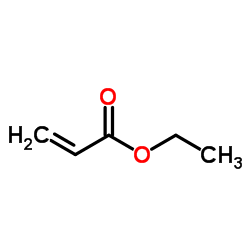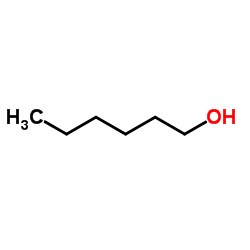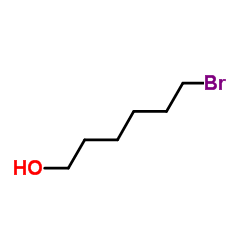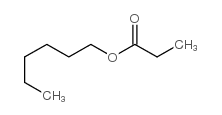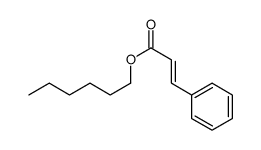2499-95-8
| 中文名 | 丙酯酸己酯 |
|---|---|
| 英文名 | hexyl prop-2-enoate |
| 中文别名 |
丙烯酸己酯
丙烯酸正己酯 正己基丙烯酸酯 |
| 英文别名 |
n-Hexylacrylate
2-Propenoic acid, hexyl ester EINECS 219-698-5 Acrylic Acid Hexyl Ester Ageflex n-HA hexyl prop-2-enoate N-Hexyl Acrylate Hexyl 2-propenoate 2-PROPENOIC ACID,HEXYL ESTER MFCD00048881 Hexyl acrylate Acrylic acid,hexyl ester acrylic acid n-hexyl ester |
| 描述 | 丙烯酸己酯是光引发CVD中的一种引发剂[1]。 |
|---|---|
| 相关类别 | |
| 参考文献 |
| 密度 | 0.9±0.1 g/cm3 |
|---|---|
| 沸点 | 191.6±9.0 °C at 760 mmHg |
| 熔点 | -45°C |
| 分子式 | C9H16O2 |
| 分子量 | 156.222 |
| 闪点 | 58.3±12.0 °C |
| 精确质量 | 156.115036 |
| PSA | 26.30000 |
| LogP | 3.45 |
| 外观性状 | 液体;Colorless to Light yellow clear liquid |
| 蒸汽压 | 0.5±0.4 mmHg at 25°C |
| 折射率 | 1.429 |
| 储存条件 | 保持容器密封,放入紧密的出藏器内,储存在阴凉,干燥的地方 |
| 稳定性 | 常温常压下稳定,避免氧化剂接触, |
| 分子结构 | 1、 摩尔折射率:45.24 2、 摩尔体积(m3/mol):175.6 3、 等张比容(90.2K):403.9 4、 表面张力(dyne/cm):27.9 5、 极化率(10 -24cm 3):17.93 |
| 计算化学 | 1、 疏水参数计算参考值(XlogP):3.4 2、 氢键供体数量:0 3、 氢键受体数量:2 4、 可旋转化学键数量:7 5、 互变异构体数量: 6、 拓扑分子极性表面积(TPSA):26.3 7、 重原子数量:11 8、 表面电荷:0 9、 复杂度:119 10、同位素原子数量:0 11、确定原子立构中心数量:0 12、不确定原子立构中心数量:0 13、确定化学键立构中心数量:0 14、不确定化学键立构中心数量:0 15、共价键单元数量:1 |
| 更多 | 1. 性状:无色液体 2. 密度(g/mL, ,20℃):0.89 3. 相对蒸汽密度(g/mL,空气=1):未确定 4. 熔点(ºC):-45 5. 沸点(ºC,常压):未确定 6. 沸点(ºC 24mmHg):88-90 7. 折射率(n 20/D ):1.428 8. 闪点(ºC):68.3 9. 比旋光度():未确定 10. 自燃点或引燃温度(ºC):68 11. 蒸气压(Pa,20ºC):未确定 12. 饱和蒸气压(kPa, 0ºC):未确定 13. 燃烧热(KJ/mol):未确定 14. 临界温度(ºC):未确定 15. 临界压力(KPa):未确定 16. 油水(辛醇/水)分配系数的对数值:未确定 17. 爆炸上限(%,V/V):未确定 18. 爆炸下限(%,V/V):未确定 19. 溶解性:不能拌和的或难以拌和 |
Synonym:Hexyl 2-propenoate; 2-Propenoic acid, hexyl este Section 2 - COMPOSITION, INFORMATION ON INGREDIENTS
Risk Phrases: 36/37/38 Section 3 - HAZARDS IDENTIFICATION EMERGENCY OVERVIEW
Irritating to eyes, respiratory system and skin. Potential Health Effects Eye: Causes eye irritation. Skin: Causes mild skin irritation. May cause dermatitis. Ingestion: May cause gastrointestinal irritation with nausea, vomiting and diarrhea. Inhalation: Causes respiratory tract irritation. Chronic: No information found. Section 4 - FIRST AID MEASURES Eyes: Flush eyes with plenty of water for at least 15 minutes, occasionally lifting the upper and lower eyelids. Get medical aid. Skin: Get medical aid. Flush skin with plenty of water for at least 15 minutes while removing contaminated clothing and shoes. Wash clothing before reuse. Ingestion: If victim is conscious and alert, give 2-4 cupfuls of milk or water. Never give anything by mouth to an unconscious person. Get medical aid. Inhalation: Remove from exposure and move to fresh air immediately. If not breathing, give artificial respiration. If breathing is difficult, give oxygen. Get medical aid. Notes to Physician: Antidote: None reported. Section 5 - FIRE FIGHTING MEASURES General Information: As in any fire, wear a self-contained breathing apparatus in pressure-demand, MSHA/NIOSH (approved or equivalent), and full protective gear. Use water spray to keep fire-exposed containers cool. Combustible liquid. Vapors may be heavier than air. They can spread along the ground and collect in low or confined areas. Containers may explode when heated. Extinguishing Media: In case of fire, use water, dry chemical, chemical foam, or alcohol-resistant foam. Use water spray to cool fire-exposed containers. Section 6 - ACCIDENTAL RELEASE MEASURES General Information: Use proper personal protective equipment as indicated in Section 8. Spills/Leaks: Absorb spill with inert material (e.g. vermiculite, sand or earth), then place in suitable container. Remove all sources of ignition. Provide ventilation. Section 7 - HANDLING and STORAGE Handling: Wash thoroughly after handling. Use with adequate ventilation. Avoid contact with eyes, skin, and clothing. Empty containers retain product residue, (liquid and/or vapor), and can be dangerous. Keep container tightly closed. Keep away from heat, sparks and flame. Avoid ingestion and inhalation. Do not pressurize, cut, weld, braze, solder, drill, grind, or expose empty containers to heat, sparks or open flames. Storage: Keep away from heat, sparks, and flame. Keep away from sources of ignition. Store in a tightly closed container. Store in a cool, dry, well-ventilated area away from incompatible substances. Keep containers tightly closed. Section 8 - EXPOSURE CONTROLS, PERSONAL PROTECTION Engineering Controls: Use adequate ventilation to keep airborne concentrations low. Exposure Limits CAS# 2499-95-8: Personal Protective Equipment Eyes: Wear appropriate protective eyeglasses or chemical safety goggles as described by OSHA's eye and face protection regulations in 29 CFR 1910.133 or European Standard EN166. Skin: Wear appropriate protective gloves to prevent skin exposure. Clothing: Wear appropriate protective clothing to prevent skin exposure. Respirators: Follow the OSHA respirator regulations found in 29 CFR 1910.134 or European Standard EN 149. Use a NIOSH/MSHA or European Standard EN 149 approved respirator if exposure limits are exceeded or if irritation or other symptoms are experienced. Section 9 - PHYSICAL AND CHEMICAL PROPERTIES Physical State: Liquid Color: colorless Odor: Not available. pH: Not available. Vapor Pressure: Not available. Viscosity: Not available. Boiling Point: 88 - 90 deg C @ 24. Freezing/Melting Point: Not available. Autoignition Temperature: Not available. Flash Point: 155 deg F ( 68.33 deg C) Explosion Limits, lower: Not available. Explosion Limits, upper: Not available. Decomposition Temperature: Solubility in water: Specific Gravity/Density: .8880g/cm3 Molecular Formula: H2C=CHCO2(CH2)5CH3 Molecular Weight: 156.25 Section 10 - STABILITY AND REACTIVITY Chemical Stability: Unstable. Conditions to Avoid: Incompatible materials, ignition sources, acids, excess heat, bases, peroxides. Incompatibilities with Other Materials: Strong oxidizing agents, polymerizing initiator. Hazardous Decomposition Products: Carbon monoxide, carbon dioxide, acrylic acids. Hazardous Polymerization: May occur. Section 11 - TOXICOLOGICAL INFORMATION RTECS#: CAS# 2499-95-8: AT1450000 LD50/LC50: CAS# 2499-95-8: Oral, rat: LD50 = 26 mL/kg; Skin, rabbit: LD50 = 5660 uL/kg. Carcinogenicity: 2-propenoic acid, hexyl ester - Not listed by ACGIH, IARC, or NTP. Other: See actual entry in RTECS for complete information. Section 12 - ECOLOGICAL INFORMATION Section 13 - DISPOSAL CONSIDERATIONS Dispose of in a manner consistent with federal, state, and local regulations. Section 14 - TRANSPORT INFORMATION IATA Not regulated as a hazardous material. IMO Not regulated as a hazardous material. RID/ADR Not regulated as a hazardous material. Section 15 - REGULATORY INFORMATION European/International Regulations European Labeling in Accordance with EC Directives Hazard Symbols: XI Risk Phrases: R 36/37/38 Irritating to eyes, respiratory system and skin. Safety Phrases: S 26 In case of contact with eyes, rinse immediately with plenty of water and seek medical advice. S 37/39 Wear suitable gloves and eye/face protection. WGK (Water Danger/Protection) CAS# 2499-95-8: 1 Canada CAS# 2499-95-8 is listed on Canada's NDSL List. CAS# 2499-95-8 is not listed on Canada's Ingredient Disclosure List. US FEDERAL TSCA CAS# 2499-95-8 is listed on the TSCA inventory. SECTION 16 - ADDITIONAL INFORMATION N/A |
|
毒理学数据: 1、急性毒性:大鼠经口LD50:26mL/kg;兔子,皮肤接触LD50:5660uL/kg 生态学数据: 对水是危害的,即使是小量的产品渗入地下也会对饮用水造成危险若无政府许可,勿将材料排入周围环境 CHEMICAL IDENTIFICATION
HEALTH HAZARD DATAACUTE TOXICITY DATA
|
| 符号 |


GHS07, GHS09 |
|---|---|
| 信号词 | Warning |
| 危害声明 | H315-H317-H319-H335-H411 |
| 警示性声明 | P261-P273-P280-P305 + P351 + P338 |
| 个人防护装备 | Eyeshields;Faceshields;full-face respirator (US);Gloves;multi-purpose combination respirator cartridge (US);type ABEK (EN14387) respirator filter |
| 危害码 (欧洲) | Xi: Irritant;N: Dangerous for the environment; |
| 风险声明 (欧洲) | 36/37/38-43-51/53 |
| 安全声明 (欧洲) | S24-S26-S37-S61 |
| 危险品运输编码 | 3082 |
| WGK德国 | 2 |
| RTECS号 | AT1450000 |
| 包装等级 | III |
| 危险类别 | 9 |
| 海关编码 | 2916129000 |
| 上游产品 10 | |
|---|---|
| 下游产品 2 | |
| 海关编码 | 2916129000 |
|---|---|
| 中文概述 | 2916129000 其他丙烯酸酯. 增值税率:17.0% 退税率:9.0% 监管条件:无 最惠国关税:6.5% 普通关税:30.0% |
| 申报要素 | 品名, 成分含量, 用途, 丙烯酸、丙烯酸盐或酯应报明包装 |
| Summary | 2916129000 other esters of acrylic acid VAT:17.0% Tax rebate rate:9.0% Supervision conditions:none MFN tariff:6.5% General tariff:30.0% |




